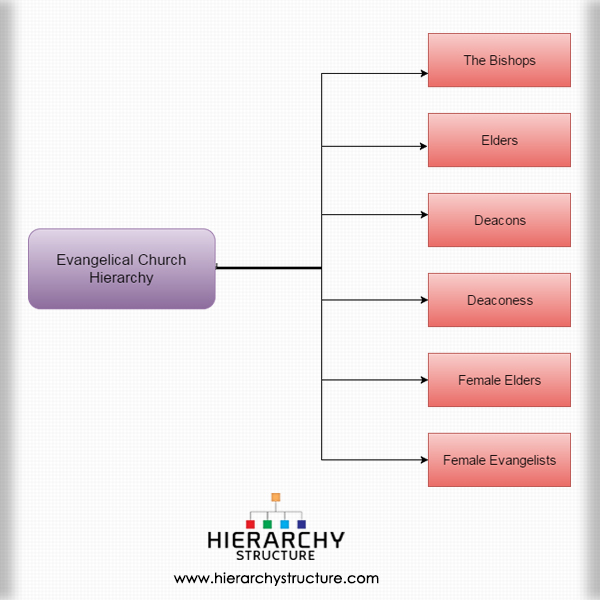The Evangelical Church is a body of American Christians chiefly of German descent. It is a Methodist Episcopal form of church government which is also known as Evangelical Association. The Evangelical Church functions on the hierarchy given below, with the help of which the organizational structure is defined.

- The Bishops: The church is usually overseen by the Bishops, where one bishop presides over a set of churches. These bishops are overseen by an archbishop, who oversees a large geographical area. They take decisions with respect to the operation and daily activities for the churches as well as taking important decisions by organizing meetings of the heads at regular intervals. The Bishop must have a wife and a family so that he can show his ability to effectively shepherd the Church of Christ. They usually need to make all the decisions taken at the meetings public.
- Elders: The Elders have the responsibility to determine the doctrine through their examination of different scriptures. The elders of congregation are bound just as members to examine themselves according to the Word of God. The only people who have the ability to oversee the Elders are the Apostles. This authority cannot be transferred to anyone else nor can the decisions which are taken by the elders can be taken by anyone else in the hierarchy, except for the Bishops.
- Deacons: The Deacon is the servant of the Church. This position does not have any specific authority rather than that of taking care of the church. The deacons are also known as ‘elders in making’ as the deacons who fulfill their duties effectively go ahead to get promoted as elders. Many Churches have deacons as heads when there is no one who can be qualified as elders at that particular time.
- Deaconess: The Deaconess also has to perform duties similar to that of the deacon, and the difference in the term is because deaconess is a female deacon. It literally means a female servant of the church and the deaconess thus has the responsibility of completely taking care of the church in absence of the Elders and the Bishops. The Deacons must be grave, not be double-tongued and should not be of greedy or filthy nature. They should be faithful in all things.
- Female Elders: Some denominations have elders as well as some authorities of the position vested with the female equivalents of the position. They are the heads of the church and they also have the authority to oversee the female deacons as well as deacons. They can assist the Bishops in taking important decisions and discussing matters which are of concern to the administration of the church.
- Female Evangelists: They have the responsibility of teaching and preaching the believers of faith who visit the church regularly. They have the rights to assist the bishops in baptizing, conducting weddings as well as funeral rites. In some churches, the Evangelists can also be Homosexuals, who have a different set of rights and responsibilities with respect to the church administration.
This is the structure of Evangelical Church hierarchy. Also know about Amish Church hierarchy.
